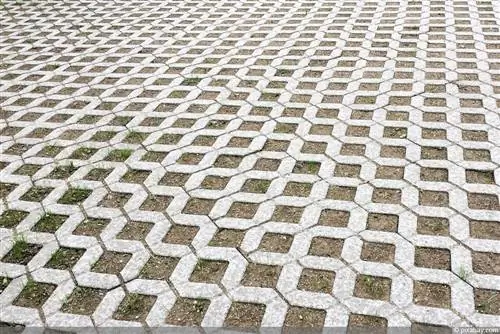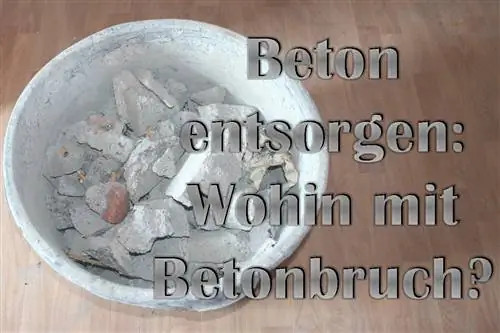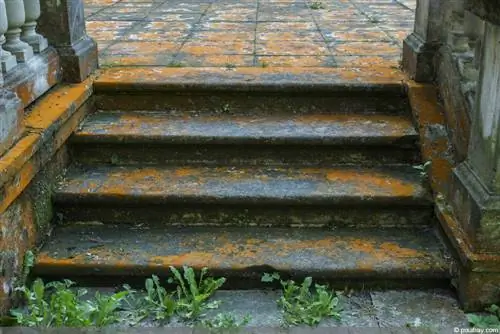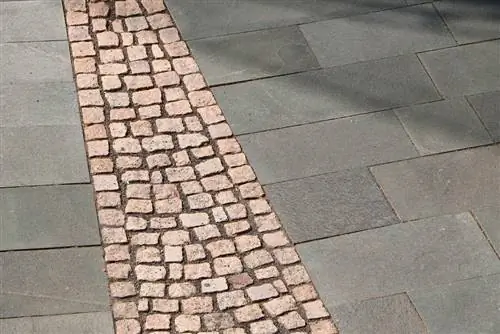- Author admin [email protected].
- Public 2023-12-23 21:05.
- Last modified 2025-06-01 06:48.
Concrete lawn pavers are now available in many designs and, more than ever, one of the most clever ways to design floor space in the transition area between the house and the garden: ecologically exemplary, easy to lay and easy to maintain, and the entire area around the house stays wonderfully green. The concrete lawn paving stones can be easily laid as a DIY project; apart from instructions, all you need is a lot of muscle power:
Advantages of concrete lawn pavers
Concrete has had quite a negative connotation for a while, dating back to the concrete construction boom of the 1970s, when our country was covered in hideous expanses of concrete, endless gray instead of green. Also on the floor, of course with floor sealing. Until geologists warned that our groundwater would soon become scarce if sealing continued at this rate. For this reason (and because the nature around us is becoming less and less anyway), areas are no longer “concreted over” if possible, but rather, for example. B. kept green with grass paving stones or even “made green again” by breaking up concrete surfaces that are then covered with grass paving stones.
Concrete grass pavers are often used for this purpose, a material with a much better ecological balance than is often assumed:
- Pure concrete without additives also consists of purely natural materials
- Namely cement, which is only called that in construction terms, from the Latin “caementum”, quarry stone or building stone
- Geologically speaking, cement consists of limestone, clay, marl (a sedimentary rock)
- Quartz sand and substances containing iron oxide may be added as correction materials for better sintering (production process by heating)
- Everything is ground into raw flour and burned, cooled and ground into cement with blastfurnace sand, fly ash, limestone and gypsum
- This cement is now mixed with sand or gravel and water, and that's it, that's concrete
- This means that concrete only consists of raw materials that occur in nature and are available in almost unlimited quantities
- All raw materials for concrete can be obtained using environmentally friendly processes
- Very little energy needs to be used to produce concrete
- Concrete production causes around 80% less CO2 emissions than plastic production
- Concrete is durable and offers a lot of resistance to weather influences (=looks good for a long time)
- Concrete is produced everywhere, there are no long transport routes
- New concrete is recycled from old concrete
- So there are very good reasons why concrete is still one of our most important building materials
The possible uses of concrete lawn pavers
Concrete lawn pavers are laid on areas that should remain green and permeable, but should still be walked or driven on regularly in the same route, without ugly “beaten paths” or lanes forming. There are some areas around the house and garden where it is conceivable to lay concrete lawn grids without a substructure: garden paths, seating islands, etc. If concrete grass pavers are to be laid in areas that are regularly used by cars and perhaps even occasionally by trucks, the green area will only remain a beautifully flat green area for longer with a professionally executed substructure:
Durable and drivable green areas with grass pavers - what is important?
The laying guidelines for grass pavers on public traffic areas contain various minimum requirements, which you can also use in private areas to ensure that the lawn pavers remain a visually attractive surface for a longer period of time:
Filter stability to prevent erosion
A water-permeable traffic area can only be secured securely if the layers of the substructure are sufficiently filter-stable among themselves. Can become critical if grass pavers are laid on water-permeable road surfaces because erosion occurs if the surface is e.g. B. is more permeable than the mineral mixture in which the lawn pavers are placed. Then geotextiles have to be in between. In the private sector, it is important that gravel, gravel and sand are selected in the appropriate grain sizes so that no rearrangement of fine minerals occurs.
Subsoil requirements
Is regulated for public areas by ZTVE-StB 94 (Additional technical contractual conditions and guidelines for earthworks in road construction, see d-nb.info/981204384/04). In private areas, sufficient water permeability, a layer thickness of the permeable subsoil of at least one meter and a distance to the highest free groundwater level of at least 2 meters can usually be assumed.
Requirements for the substructure
For public areas again in accordance with ZTVE-StB 94, in private areas the necessary permeability coefficient is usually achieved uncritically using normal garden soil. This permeability coefficient (Kf value, to be determined according to DIN 18130-1), which describes the permeability, can cause problems in heavy soils that consist almost exclusively of clay or loam. If you are struggling with such soils on your property, you have usually already known about it (because you had to lay drainage when you built your house - if not, your first point of contact would be your local environmental agency). Then your substructure for the lawn paving stones may have to be made correspondingly thicker so that the water always drains off without any problems. You can perhaps find out how strong it is from a friend (who can put you in touch with the foreman of a road construction company) or from an expert in road and path construction (who can't charge a fortune if he spends half an hour with what you need Shift construction busy).
Requirements for the base course
In public areas, base layers and frost protection layers must be designed in such a way that each building material mixture is tailored to the requirements for water permeability and load-bearing capacity. For base layers without binders, coarse-grained mineral mixtures with a maximum grain size of 32 mm, 45 mm or 56 mm are prescribed here, grading curves in the coarse-grained grading range (for grading ranges for grain mixtures see https://www.hlug.de/fileadmin/documents/geologie/rohstoffe/Fachbericht %20Sand%20%26%20Kies%2015%2011%2006.pdf) and a certain load-bearing capacity (deformation modulus Ev2=120 MN/m², on the top edge of the base layer). All of this according to ZTVT-StB 95/2002 (Additional technical contractual conditions and guidelines for base courses in road construction, see www.ulb.tu-darmstadt.de/tocs/111384192.pdf) and TL SoB-StB 04 (Technical delivery conditions for building material mixtures and soils for the production of layers without binders in road construction, see www.lbm.rlp.de/icc/Internet/nav/459/broker.jsp?uMen=45940232-4d31-1c31-01ce-18c40a7fd727&_ic_print=true), comprehensive treatises on the construction of base courses, the procurement of which may be necessary in critical cases. also worthwhile in the private sector. In non-critical cases, simply use gravel, gravel, sand of the above-mentioned grain size from a rather coarse-grained grading range, and when purchasing, have the dealer assure you that the grass paving stones with the intended substructure will support your vehicle and also the truck that may deliver oil (You don't install on public areas where even the heaviest fire truck etc. shouldn't break in).
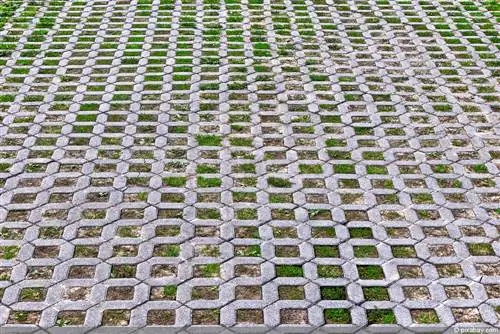
Bordering
In public areas, an all-round edge border is always provided for the area to be covered with grass pavers. In the private sector, there are also reasons to provide edge edging on all sides; this should and can prevent the stones in the edge area from shifting during use and absorb the horizontal forces acting on the surface.
Gradient
is intended for public areas and must also be installed in private areas so that rainwater can drain away. Normal is 2 to 2.5%, but different conditions may apply in individual cases.
Bedding requirements
Lawn grid stones are laid in public areas on a bed of at least 4 cm thick natural stone chippings with a grain size of 2/5 mm, whereby the filter stability of the bed in relation to the base layer and sufficient water permeability must be guaranteed. Also applies in private areas, whereby lawn pavers with little load can be embedded in sand.
Joints and seepage openings
For both areas: Grass paving stones must be laid with joint widths between 3 and 5 mm. This is recommended due to the permissible dimensional tolerances of the stones, the expansion and compression of the concrete and to avoid edge chipping. Seepage openings (the middle of the lawn paving stones) and joints should be filled with natural stone chippings with a grain size of 2/5 mm before shaking off. If the lawn pavers are to be covered with greenery, a mixture of 40% topsoil, 20% grit 2/5 mm, 20% lava 0/5 mm and 20% compost soil should be filled in public areas, to which a mineral fertilizer has been added. A short-growing, drought-resistant standard seed mixture (RSM) is prescribed for sowing. You should stick to this in your private life too, a tested standard seed mixture simply brings more than a package with a nice name.
Shake off
“Public” grass pavers should always be compacted (regardless of the stone thickness) using vibratory plates with an operating weight of a maximum of 130 kg and a centrifugal force of approx. 20 kN. The use of a plate sliding device (hard rubber apron) is required to avoid damage to the surface and edges. Only in smaller areas with grass paving stones is it assumed that laying them using a hammer can ensure sufficient positional stability (but this tapping with a rubber mallet is really annoying).“To shake or not to shake” is a debate that always comes up when laying grass pavers. There is talk of concrete crumbling after shaking, cracked stones, chipped edges - everything that can happen if you shake off grass paving stones on a base layer that is too poorly compacted with a vibrating plate that is too heavy (for your own strength and ability) but not dampened by a rubber apron. Here you should avoid any discussion and better stick to the rules for professionals. On the contrary, the better and more firmly you compact each of the substructure layers, the lower the risk of damaging the grass paving stones when shaking them, and the more durable and (durable) even the overall area will be. If you do not shake off areas that are being driven on, or if you do not shake them carefully and hard enough, you will later “shake off” the area by car, and that will quickly create lanes that will never go away, and perhaps even broken stones when you are maneuvering or driving If you don't hit the same track the next time you drive, a creative hilly landscape is created, but it doesn't look that great.
Laying concrete grass pavers
As far as the official regulations that specify the “optimal theory”, now an overview of the implementation in practice:
(Almost) lay without substructure
If your concrete lawn paving stones can be laid without a substructure due to low loads, it's pretty easy: The stones are buried so deep that they form a flat surface with the surrounding ground. Then fill it with soil, slurry it in, wait 2 weeks, top up if necessary and then sow lawn or plant with walkable ground cover. If you want to create a small bed for lawn paving stones in loose soil, remove a layer of about 5 cm, fill this layer with sand and lay the stones in it as described above. You can mix in topsoil for the filling; the lawn mixtures mentioned above and sturdy ground cover plants that can cope with lean soil are suitable for planting.
Stable substructure
To create a resilient substructure for traffic areas, remove around 50 cm of soil. Level the ground. In the past, water-permeable weed fleece was sometimes laid out. Since this goes against the purpose (greening, infiltration), this is no longer recommended today. Now the base layer of 35 cm of coarse gravel is evenly distributed and well compacted with the vibrating plate described above (from the construction equipment rental company). When the coarse gravel layer is solid, a second layer of gravel about 5 cm thick is placed on top. It should consist of fine fine chippings. This is removed evenly and cleanly and then compacted well. Goal in terms of layer thickness: After shaking, the layer of fine chippings should be 1 cm higher than the finished surface, because the grass pavers sink approximately 1 cm when shaking.
Laying lawn pavers on a stable substructure
The lawn paving stones can then be laid together on the surface:
- The honeycomb lawn grid stones simply need to be placed, they are designed to fit together automatically
- Design lawn pavers are placed at the intervals specified in the manufacturer's instructions
- When the grass pavers are in place, the filling can be added for the planting
- It is slurried in and then sprinkled with sand after the standing water has seeped away
- Then again it is well compacted
- If available, you can place a steel plate or formwork boards on the surface so that you can compact the surface with even pressure over a large area, and the vibrator should definitely be equipped with a rubber plate
- Do not use a so-called “frog” for shaking, its contact surface is too small and tends to destroy any edge it lands on unprotected
- During compaction, the filling settles, usually something needs to be refilled
- For most stones, the filling should end slightly below the top edge of the stone for static reasons, so 3 to 5 mm
- Now a back support (sloping support made of mortar) can be attached; if necessary, it can also serve as a bed for the curbs
- Now the lawn can be sown, think about spreading a regular seed mixture for robust lawn
- The young grass should be mowed for the first time when it is 6 to 8 cm high
- The more often you mow (the tips), the better strong undergrass and densely rooted turf will develop
Conclusion
Concrete lawn pavers are fairly easy to lay for any subsequent load level. However, the better (and more often) the laid surfaces are compacted during installation, the more durable they will be - you will probably have to be prepared for a lot of sore muscles when you lay your DIY lawn grid.

